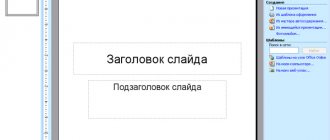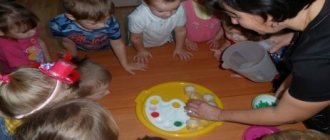Additional literature:
1. “Oral counting in horror stories and funny stories” by T. Rick.
I actually bought all the books of this author. (For the Russian language, I highly recommend her fairy tales)
2. “How to learn the multiplication table. And not only!"
I really liked the book, it has a lot of ideas not only for studying the multiplication tables, but also other school (and not only) information.
Firstly, with the help of this book you will be able to determine the leading type of memory of your child (and any adult) and choose the most suitable memorization methods for him.
“Methodological recommendations for the mathematical development of children of senior preschool age”
METHODOLOGICAL
RECOMMENDATIONS
ON MATHEMATICAL DEVELOPMENT OF SENIOR PRESCHOOL CHILDREN
Educator:
Biryukova Ekaterina Yurievna
MBDOU "Kindergarten No. 59 "Yagodka"
Tambov
What is activity in cognitive activity or what is cognitive activity?
The cognitive activity of a preschooler can be characterized as a manifestation of independence, initiative, and creativity in the process of activity. This is the desire to learn, comprehend, understand, find, and experience the joy of success from independently finding a way to solve a cognitive problem.
The prerequisite, the physiological basis of cognitive activity, is certainly an oriented reflex: “What is this?” But the precondition can develop into a quality called cognitive activity only under certain favorable conditions. The main task of pedagogy is to create such conditions.
This includes, first of all, the development of motives for learning activities, as well as knowledge, skills and an emotionally positive background for learning.
Activity manifests itself mainly:
- the ability to see and independently set a cognitive task;
- draw up a plan and select ways to solve a problem using the most reliable and effective methods possible;
- achieve a result and understand the need to check it.
These provisions already show: the cognitive activity of children cannot be considered as a volitional, purposeful action, where the goal most often goes beyond the immediate situation.
In this case, cognitive activity is the mobilization of intellectual, moral-volitional and physical forces to achieve specific learning goals. We proceed from the position: activity in the learning process is determined not by motor activity, not by the degree of employment, but by the level of mental activity, which carries elements of creativity.
And it is absolutely necessary to remember that the age characteristics of children (even older preschool age) make it possible to organize an active state in the learning process, but rather connectedness in the learning process, connectedness with individual main tasks of a specific task.
It is known that cognitive activity begins with living contemplation in a broad sense - with sensations and perceptions.
Children observe, listen, examine, apply, measure, examine the shape of objects, etc. Already this stage of learning is characterized by activity. However, in these cases it would be more correct to talk about general mental activity.
At the beginning, the child develops the ability to see, hear, compare specific objects directly, determine their color, size, shape. Somewhat later, the ability to analyze, compare, contrast, draw conclusions, etc. appears. At the same time, mental actions acquire a special connotation - the desire for independence.
By what indicators can a teacher judge the activity of children in the learning process? This is, first of all:
— passion for studying the material (concentration, attention);
- a clearly expressed desire to perform a variety of, especially complex tasks;
- desire to continue classes (often such children themselves are the initiators of games, joint cognitive activities with adults: they offer to play, consider, find a way);
— manifestation of independence in the selection of means, methods of action, achieving results, and exercising control;
— use of knowledge in independent activities (play, work, constructive);
- contacting the teacher with questions aimed at cognitive interests;
— quality of knowledge and skills (awareness, flexibility, efficiency).
In such cases, children achieve the goal not intuitively, but consciously, and are able to explain how they performed the action and why exactly (“Why do you think that this problem is given for addition?” - “Because the problem says that the children took three large and two small balls. Do you need to find out how many balls they took? To do this, you need to add them up").
In the process of mathematical development, much attention is paid to the formation of knowledge and extremely little to mastering methods of activity.
Mathematical knowledge in independent activities: (children build buildings, ignoring the ratios of objects in size, play “shop” without resorting to counting, set the table without proper orientation to quantitative relationships), diagrams, diagrams, tables, where it is possible to compare and analyze , generalize, abstract.
In individual work with each student, the teacher can maximize cognitive activity, identify the characteristics of this activity, build on what has been achieved and help to rise higher, using the desire for independence for this.
Cognitive activity is formed mainly in cognitive activity, which is associated with the purposeful actions of children. Pedagogically correctly organized activities contribute most effectively to its formation. Formed in the process of activity, cognitive activity at the same time affects the quality of this activity. Activity here acts as a means and as a condition for achieving a goal.
In our pedagogical work, we proceeded from the position: cognitive activity is always individual in nature. For some children it is higher, for others it is lower, some need certain means, others need others. And, nevertheless, as experience shows, it is possible to increase the cognitive activity of all children and each individual in the following way. This:
— strict selection of the content of educational (cognitive) material for each lesson, reasoned, logical connection between the parts of this material;
— adequacy (compliance) of methods and teaching techniques with the program content of the lesson;
— creating optimal conditions for independent work;
- a combination of collective and individual forms of educational (cognitive) activity in and outside of class.
By integrating program tasks for each lesson, we strive to ensure that children’s educational activities simultaneously influence the intellectual, emotional, and moral-volitional sphere of each person’s personality. This required, first of all, to improve the means and methods of teaching, to increase the time and variety of tasks for independent work. In order for children to understand the goal setting of the lesson - and this is what we consider the main thing - the teacher, communicating the topic and main cognitive objectives of the lesson, clearly highlighted what new things they will learn today, what they will learn. At the same time, he was in no hurry to give ready-made knowledge or immediately show implementation techniques, but always provided the opportunity for independent search and creative solution to the problem.
The cognitive activity of children must be in strict accordance with the main objectives of the lesson and the stage of formation of knowledge and skills. So, at the first stage - the formation of knowledge and skills - the activity of the teacher should be higher. He is obliged to show the methods of performing the activity, the sequence of actions, etc. At the second stage - consolidation - it is quite natural to introduce greater independence and activity to children.
Of course, he pays special attention to children who are more difficult to learn the material than others. As a rule, the teacher works with them before learning new material. So, the day before the upcoming lesson, the teacher says to the child: “Soon we will get acquainted with a new figure, no one knows what it’s called yet, but I’ll tell you now, just try to remember - it’s a rhombus (cone).” The child repeats the name of the geometric figure and examines it together with the teacher. On the eve of the lesson, you can once again remember what it is called and how it differs from those already known.
After such preparation, it is naturally easier to cope with the task and, as a rule, the child is active during the lesson.
At each lesson, organizing cognitive activities, the teacher strives to ensure that in individual work children develop the ability to analyze, compare, generalize, and prove. It is important to create conditions for the manifestation of independence and creativity, to provide children with the opportunity to take initiative and find their own ways of solving a cognitive problem.






